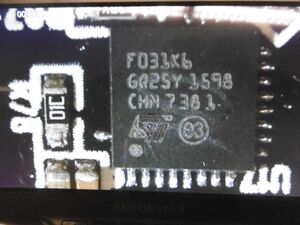Understanding the SDS011 particle sensor: Difference between revisions
| Line 46: | Line 46: | ||
== The Software == | === The Software === | ||
A complication for re-programming the STM32 is that the programming pins (SWD) are cut off in the manufacturing process, see photo. | A complication for re-programming the STM32 is that the programming pins (SWD) are cut off in the manufacturing process, see photo. | ||
We discerned three possible scenario's for re-flashing the firmware. | We discerned three possible scenario's for re-flashing the firmware. | ||
Revision as of 19:14, 7 March 2020

Particle sensor SDS011, understanding its inner workings
On March 3rd, Cmpxchg and Oberoid placed the infamous SDS011 particle sensor on the dissection table at Revspace. The SDS011 is extensively used for citizen science projects when air quality is in doubt.
Our goal is to create a new algorithm for its micro-controller which can be published in the public domain and is therefore open for the scrutiny of others. This article is a log of our findings while opening up the sensor and also a description of the process of understand the physics behind the functioning of the device.
Operation of the SDS011
In the SDS011 particles are detected by recording the light that is scattered by the dust particle when hit by a laser beam. The scatter patterns are picked up by a photo-diode which signal is amplified and then fed to a micro-controller. The micro-controller interprets the data stream and relates it to known properties of representative dust samples. The algorithm behind the this fitting is unknown.
Closed Firmware
Recently a number of scientific articles appeared that try to assess the validity of the SDS011 sensor. However, little is published about the exact physical inner workings of the device, nor on its pre-programmed firmware. Until now researchers take the functioning of the device as a black box, its firmware is considered corperate property and therefore cannot be tinkered with.
The SDS011 is also the preferred sensor in most citizen science campaigns of governmental initiatives in Germany, The Netherlands and Belgium. For example in the monitoring campaign “de Schone Luchten”, the SDS011 plays a central role in gathering date for the public dialogue about dust exhaust of a local steel mill. Within the scientific community as in the groups of concerning citizens there is a growing concern about the the scientific significance of the data collected by the SDS011.
To estimate the scientific value of the data gathered by the SDS011, we think that it is important that the working of the device should be open to the public. Therefore we decided to open up the apparatus and investigate its inner workings.
The goal of this project is to not to crack the corporate code of the SDS011, but instead to reprogram its micro-controller with a new algorithm that forms the basis for future development of particle sensors in the public domain.
People that are interested in this project can visit the RevSpace Hackerspace, which is accessible every tuesday on the social night.
Reverse engineering
The follow effort needs to be done to get more information about the pcb board and the sensor. This info can then be used to feed a physicist with a theoretical model of potential measurements that can be performed with this setup.
The board
The board might be reverse-engineerable.
To do:
- Determine the GPO and GPI of the STM32 while processing
- Measure the control circuit of the laser module.
- Create a matching circuit, filtering and gain of the instrumentation amplifier analysed.
The sensor
The following actions need to be done
- Determine type of the photosensor
- Measure size of size of hole before sensor.
- Create a layout of the lightbox. Angles of second order reflections drawn.
- Measure air speed.
- Estimate the focus area of laser beam on the airflow.
The Software
A complication for re-programming the STM32 is that the programming pins (SWD) are cut off in the manufacturing process, see photo. We discerned three possible scenario's for re-flashing the firmware.
- reconnecting the copper ends of the cut-off SWD pins
- via the UART, with help from the BootP pin.
- replace the microcontroller on the pcb with a new one, and put an opensource booloader on it
Software control
Firmware update
Can probably be done via a bootloader and application, over UART. Needs to be explored.
Experimental Drivers
Create bare-metal drivers for:
- Blink a led, visual debugging
- Laser control, PWM
- ADC
- UART
The drivers can be tested with short burst of raw measurements, to be output over UART. The developing of the drivers using a easy to use tool chain needs to be established.